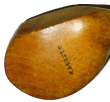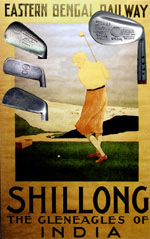
|
Registration Edit profile catalogue auction shopping cart shipping history makers search faq news links about contact |

Scottish Golf History
The Far EastGolfing exports to India and China(Source: © 2004, Douglas MacKenzie) A version of this article was originally published in Golf Vacations, December 2004 A bonus in finding an old golf club in Scotland is if it is stamped with a reseller's name such as R S Sen Bros Newmarket Calcutta or Robinson & Co Singapore as it has a great deal of social history as well as golfing stories to tell. Golf had been exported eastwards early with the first course in India laid out at Dum Dum on the outskirts of Calcutta in 1829. Both this, which became The Royal Calcutta Golf Club, and the club formed in Bombay in 1842, had strong connections with Royal Blackheath and handsome medals and trophies were exchanged between India and London. The expatriates naturally looked homewards for their golfing supplies and the Bombay minute book of 1877 records an order for '4 dozen No 27 size; 16 dozen No 28 and 4 dozen No 29 golf balls' (the number referring to the ball's weight) plus '24 drivers, 24 long spoons and 24 driving niblicks with wooden heads and brass bottoms' with the added note 'none to be ordered from Morris'. What Old Tom had done to incur the wrath of the sahibs is not known.
It was from the 1890s until the end of the hickory era in 1929 when the bulk of clubs were shipped. This coincided with the second wave of British emigration, what Charles Allen in Tales from the South China Seas called 'the consolidators', teachers, planters and engineers. The most visible presence was again in Calcutta where many came from Dundee and Fife to establish jute works on the banks of the Hooghly. So successful were they in this that, within thirty years, they had killed manufacture at home in Dundee. The increasing numbers of golfers led to a rapid growth in golf clubs, 39 are listed in India in the 1912 Golfer's Handbook, three courses were developed in Singapore from 1891, another in Kuala Lumpur two years later , China had courses from Wei-Hai-Wai on an isolated eastern peninsula to Tientsin the far north. With this, of course, came a huge demand for clubs. In an age of giant multinationals it is interesting to look back on the major exporters of clubs at the turn of the century. David Anderson and Sons had twelve clubmakers working in their St Andrews shop in 1904 (and four of these were David's sons). Even the giants, Robert Forgan and Son, had only 37 employees in 1895. Nor, despite the industrial revolution, were these concerns in large manufacturing cities but in small Fife fishing villages and towns, Anstruther, Elie, Kinghorn and St Andrews. It was niche export marketing to make modern Scottish economic agencies salivate. The ultimate specialist order was probably that of Tom Auchterlonie who made sets of clubs for the Japanese Imperial family in 1925, each club stamped with the mark of a lotus blossom. This is not to say no clubs were produced locally. The author has seen transitional wooden playclubs (from the 1890s) marked Zutshi Bros Sialkote, (modern day Pakistan). These were reasonable copies of clubs made in Scotland at the time. However, innovation, or at least parallel evolution, existed also. Cross-head, or simplex, clubs with two striking faces, based on the croquet mallet, caused a stir in Britain and were patented in 1904 and, ultimately, banned by the R&A in 1911. In the intervening period the editor of Golf Illustrated received a letter from a gentleman who had golfed in Java pointing out that players there had been making and using clubs of this design since 1896. There is a pleasing symmetry to the export of the implements of the game from Scotland for, without Singapore, there would never have been a need. Although the much quoted story of Robert Adams Paterson making a ball from gutta percha chips used to pack a statue of Vishnu sent to St Andrews has little credible basis, Jose d'Almeida, a Portuguese merchant in Singapore, had sent samples of the gum to the Royal Asiatic Society in London in 1843 and the material's rapid adoption, in everything from submarine cables to medical tool handles, led to experiments in golf ball making. It was the advent of the gutta percha ball in 1848, replacing the expensive, labour-intensive featherie, which made golf affordable in Britain and allowed its worldwide growth to begin. |
site design dmc ltd | © 2000-2024 Antique Golf Clubs from Scotland
